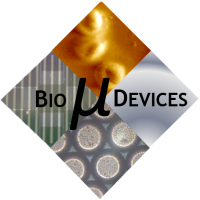| Juliana CHAWICH is new Phd student who joined our team (Biomicrodevices) on October 1st 2015. She started a thesis entitled "GaAs-ZnO sensors array for the determination of biological entities". This thesis work will be executed in partnership between our group (Pr T. Leblois, Dr. C. Elie-Caille) with the University of Sherbrooke (UMI LN2, Canada), within the team "Quantum Semiconductors and Biophotonics" (Lead : Pr J. Dubowski). |
Detailed summary of the thesis:
The PhD work focuses on the design, fabrication and characterization of a GaAs/ZnO acoustic microsensors network/matrix, for real-time dosing of biological entities in complex fluids. The originality of the project is based on the matrix structure of the assay device that will help to increase the speed of analysis, the diversity of captured targets, the specificity and the speed of response by multiple and simultaneous measurements. GaAs is a material combining multiple advantages: a possible direct biofunctionalization of its surface, a large variety of 3D structure microfabrication, a transduction process conferring a good sensitivity to the sensor, and a possible associated microfluidic realizable by inexpensive cleanroom processes. The contribution of structured ZnO thin film on a GaAs doped membrane is a real asset to achieve the desired goal in the thesis. The doping of GaAs substrate and the use of a ZnO active film is an alternative to the direct use of bulk GaAs that has been recommended in literature. Indeed this ZnO/GaAs doping would provide a better state of sensor surface, (a better flatness and homogeneity), and especially a much smaller membrane thickness. Raising this technological barrier will increase the sensitivity of the sensor, while maintaining low cost manufacturing processes.
The PhD work will focus on the study of the energy confinement of a resonant device and of the coupling / uncoupling of several resonant devices, in order to improve their performances. Measurements of metrological parameters on the membranes matrixes will be confronted with the modeling / simulation of the proposed structures (geometry, electrodes ...).
This thesis is based on previous results (2 previous PhD thesis : Dr. Alex Bienaimé (2009-2012), Mr Vivien Lacour (2012-present)) obtained both 1) at the FEMTO-ST Institute and especially MN2S department : microfabrication by cleanroom processes of vibrating membranes from bulk semi insulating piezoelectric GaAs, modeling of acoustic transducers, and microfluidics developments and 2) at the Sherbrooke University (Canada) in terms of realization and characterization of biofunctionalized GaAs interface by FTIR especially. It is also based on the work of A. Bartasyte (FEMTO-ST Institute, MN2S department) on deposition / characterization of piezoelectric layers.
Once the GaAs/ZnO sensors network will be characterized, our goal is to test it for bacterial detection and quantification in fluids. Indeed, bacterial quantification in a complex fluid is a challenge for health, in the field of disease diagnosis or treatment, but also for environment or food processing, in the field of water pollution or food contamination.

